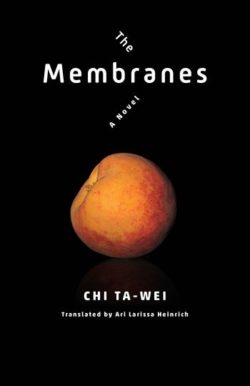The Membranes, by Chi Ta-wei
translated by Ari Larissa Heinrich
Columbia University Press, 2021
Publisher's Blurb
It is the late twenty-first century, and Momo is the most celebrated dermal care technician in all of T City. Humanity has migrated to domes at the bottom of the sea to escape devastating climate change. The world is dominated by powerful media conglomerates and runs on exploited cyborg labor. Momo prefers to keep to herself, and anyway she’s too busy for other relationships: her clients include some of the city’s best-known media personalities. But after meeting her estranged mother, she begins to explore her true identity, a journey that leads to questioning the bounds of gender, memory, self, and reality.
First published in Taiwan in 1995, The Membranes is a classic of queer speculative fiction in Chinese. Chi Ta-wei weaves dystopian tropes—heirloom animals, radiation-proof combat drones, sinister surveillance technologies—into a sensitive portrait of one young woman’s quest for self-understanding. Predicting everything from fitness tracking to social media saturation, this visionary and sublime novel stands out for its queer and trans themes. The Membranes reveals the diversity and originality of contemporary speculative fiction in Chinese, exploring gender and sexuality, technological domination, and regimes of capital, all while applying an unflinching self-reflexivity to the reader’s own role. Ari Larissa Heinrich’s translation brings Chi’s hybrid punk sensibility to all readers interested in books that test the limits of where speculative fiction can go.
Reading Chinese Network Reviews
Reviewed by Roseanna Sonnenberg, 29/11/21
 The Membranes by Taiwanese writer Chi Ta-wei was originally published in 1996; whilst the English edition, translated by Ari Larissa Heinrich, was published in 2021, twenty-five years later. What is interesting is, that it feels just as topical today as it was then. Especially having read this shortly after COP26 has taken place.
The Membranes by Taiwanese writer Chi Ta-wei was originally published in 1996; whilst the English edition, translated by Ari Larissa Heinrich, was published in 2021, twenty-five years later. What is interesting is, that it feels just as topical today as it was then. Especially having read this shortly after COP26 has taken place.
Set in the future, Momo (a name which is the Japanese pronunciation of peach) is the central character, born in 2070. We arrive at a time when climate change has devastated the Earth and since 2060, 99% of humans have migrated to the ocean floor. Momo, reaching the age of thirty, is a renowned dermal care technician, who lives and works in T City, in her own infinity-shaped clinic (Salon Canary), in New Taiwan: “...the financial center of (undersea) Southeast Asia.”
So what are the membranes? Membranes are a theme that recur across the story, in different ways. For example, the ocean is “...a perfect protective membrane...that could shield humans, animals, and plants from ultra-violet radiation.” And Momo applies a special lotion to her clients called M skin, which appears to act as a layer of protection – keeping toxins out. A membrane can also be seen as a cage, keeping things in. There are references to canaries in cages – and with this, the plot starts to become more intriguing and rather more complex than it first appears.
The story is particularly enjoyable because it centres around one main character, Momo. The Earth’s situation is explained in some detail, which provides a solid context for Momo’s life, but the actual story is based on Momo – her relationship with herself and with others, especially her mother. There are issues that need to be resolved and answers that must be found, which makes the book a page-turner.
There are many references to films and writers in the story. This also works really well to ground the plot for me. The references provide a rich context. It is possible to imagine this world because it is illustrated with vivid scenes that have been seen in life before – like canals from films in Venice.
Most of the characters discussed are female. It appears Momo has two mothers and she was born from a peach – just like a fairy tale child and just like her name. How was she really created? To what extent is gender necessary in this future world? Plus, how much does it matter if human organs fail in this world? A finger transplant, for example, seems very easy and not overly painful here.
This book poses many questions about life as it is and how it could be. These questions have continued for me after I finished the book, really highlighting its success as a novel.
Overall, I enjoyed this story because, whilst much initially appears aboveboard, there is a great sense of mystery and “...shadows...” around everything. The translation by Ari Larissa Heinrich is compelling to read.
I would also say that there is a final plot twist that I didn’t see coming, even though I really thought I was starting to work everything out. This just makes Chi Ta-wei’s story even better.
Reviewed by Roseanna Sonnenberg
Reviewed by Michelle Deeter, 8/10/21
 It’s great when a science fiction novel can both surprise the reader and seem like an alternate reality that could occur. The Membranes by Chi Ta-Wei manages to do just that.
It’s great when a science fiction novel can both surprise the reader and seem like an alternate reality that could occur. The Membranes by Chi Ta-Wei manages to do just that.
Momo is a 30-year-old dermal technician living in T-city, somewhere in East Asia. She seems a little weird but in a likeable way. She says that “she felt that there was at least one layer of membrane between her and the world” at the beginning of the novel, and that isolation ends up being a key part of understanding her character. She does not have any friends, nor does she have any family apart from her mother. It is the year 2100 and she lives underwater—most people decided to live underwater after the ozone layer was destroyed. Momo excels at her job, giving massages and applying lotions to the rich and famous, but she does not like to socialize. Rather than going to parties, she reads books and watches films on her computer. Parts of the world are at war, and there are amphibious snipers on the land, so people are discouraged from going to the surface. Most people seem to stay in their bubble, where it is safe.
At the halfway point in the book, I thought the story was believable but found it a little bit dull that Momo never interacted with other people. She only wanted to talk about a friend named Andy who died when Momo had a major operation as a child. Momo gets a dog, but the cute companion does not seem to change her life in any way. Then a twist happens and the story adds a little more background to Momo’s situation and Momo’s childhood operation. The story led me to ask a number of questions. What does it mean to sacrifice for one’s family? How do we define a successful upbringing of a child? How do we define a happy life? How can we protect our children from harm, or should we accept that children have to face dangers every day?
The translation, by Ari Larissa Heinrich, works incredibly well. The characters were sensitively portrayed and the dozens of references to books, songs and films were correctly translated as far as I could tell. In a novice pair of hands, this book might have seemed to be odd, putting too much emphasis on Momo’s queerness and Momo’s mother’s queerness. Instead, the character’s motivations are clearly explained and the plot seems possible for something happening in 2100. I was shocked to learn the Chinese version was written in 1996 because it feels like it was written just last year. The character motivations and the dystopian world are still relevant today.
I think science fiction readers should definitely give this book a try. With its intense focus on a small number of characters, limited worldbuilding, and slower pacing, The Membranes is radically different from a classic American science fiction novel. But I think that is a feature, rather than a bug. Any science fiction that manages to make us think outside of the box is great science fiction!
Reviewed by Michelle Deeter
Reviewed by Paul Woods, 12/7/21
 Chi Ta-wei’s science fiction novel about dermal care technician Momo is a festival of creativity and critique which forces the reader to confront various social and economic trends in our world. The story is full of physical and metaphorical membranes, places where two worlds or systems meet.
Chi Ta-wei’s science fiction novel about dermal care technician Momo is a festival of creativity and critique which forces the reader to confront various social and economic trends in our world. The story is full of physical and metaphorical membranes, places where two worlds or systems meet.
The inhabitants of the world of the future live below the sea, due to the devastating effects of climate change, yet can see the membrane between ocean and sky. Momo lives on her own and has a small number of elite clients whom she meets at her salon, an advance booking system and the structure of her premises constituting an interface or membrane between her life and work and the world outside. Another physical membrane is the M skin which Momo applies to the skin of her clients, giving her access to their experiences.
The metaphorical membranes are more powerful and disturbing than the physical. Chi’s critique of late 20th century tech-capitalism explores how big business has become as important as government, the functions of the two overlapping in ways that resonate with our current concerns about the vast power of companies such as Amazon and Google, now discussed at G7 meetings. Some readers have commented on the use of ‘MegaHard’ for the name of one of the dominant infotech companies. One perfectly reasonable limitation of Chi’s prophetic work is his concern at the power of technology per se -- hence his implicit dig at ‘Microsoft’ -- but a quarter of a century after The Membranes originally appeared, true power now lies with companies which combine technical innovation with internet-based marketing, algorithms, and home deliveries. In fairness to Chi, no one really anticipated the all-pervasive influence of the internet and its algorithms; his use of laser disks as a means of content delivery places the book in a time before cloud storage, Wi-Fi, and instantaneous downloads.
Rather than following a classic plot as we might understand it, the book proceeds more along the lines of a gradual revelation of the truth. Membranes persist, as contradictory and complementary concepts come together, juxtaposed into a liminal space. We are led to believe that Momo and her special friend Andy have coalesced, surgery when she was a child moving the membrane between them from outside of Momo to inside her and shifting her from male to female. Another binary opposition is problematised as Momo’s mother, initially portrayed as cold and indifferent to her daughter, is revealed as doing her utmost to protect her and hence moves from villain to heroine.
Towards the end of the story we learn of yet another shift in the interface between Momo and the outside world. The surgery which took place when she was small was a failure and all that remained was her brain. Momo has spent 20 years as a brain-in-a-vat, her whole life a Matrix-like construct of data manipulation. Her brain and mind, hardware and software, are wrapped in a membrane which sustains her and allows her to experience the world in a mediated way while working to earn her keep, so to speak. The membrane between consumer and consumed becomes very thin and the two roles are joined: Momo thought she was a well-off, highly regarded person who benefited from the consumer society around her when in fact she was a resource for a tech company. Even her experiences as a dermal care technician were false. Rather than taking care of the skin of beautiful people she maintained machines; one kind of experience was turned into another by a computer system which acted as a membrane to process and reinterpret her world.
The Membranes is a powerful story which asks awkward questions about tech capitalism, technology itself, and human responsibility. It is disturbing in that its dystopian view of an exploitative world initially appears far from our own, until we see ourselves in Momo, not as brains-in-vats, but as data sets for large tech companies and marketing people of all persuasions. Recent political trends in the UK and US have shown how social media and big data can influence the democratic process and thus we encounter a thin membrane joining business and politics. At the end of the book the reader is not sure how much Momo understands of her own predicament. What about us? It is time for a sequel to The Membranes.
Reviewed by Paul Woods
Reviewed by Stella Jiayue Zhu, 28/4/21
 What is reality? And what constitutes the authentic human being? In a 1978 speech, Philip K. Dick told his audience that these two questions were the leitmotif preoccupying him as a sci-fi writer for nearly thirty years.
What is reality? And what constitutes the authentic human being? In a 1978 speech, Philip K. Dick told his audience that these two questions were the leitmotif preoccupying him as a sci-fi writer for nearly thirty years.
To encapsulate Chi Ta-Wei’s 1995 award-winning sci-fi novella The Membranes, I couldn’t think of a better way than to evoke PKD in that moment. Being the short story it is, The Membranes presents a tight, absorbed investigation on the exact same themes. With probity and tenderness, Chi even manages to offer something like an answer, though by no means final, of an ingenuity and sophistication not unlike PKD himself.
Set in a dystopic near-future cohabited by humans and droids, The Membranes is a rendition of the classic brain-in-a-vat (BIV) science fiction trope. It tells the story of Momo, a thirty-year-old celebrity dermal aesthetician navigating her relationship with her body, her desires, and her childhood. Unbeknownst to Momo, her life is a fabrication in the literal sense. For twenty years, the events she experiences have been scripted in detail by her own mother in an attempt to shield Momo from a gruesome reality. Momo is, in fact, a disembodied brain on a twenty-year work lease to a munitions mega-corporation; and the scrupulous dermal care Momo thinks she is providing to human customers is in actuality repair work on combat cyborgs.
A typical BIV story capitalizes on the horror and allure of imaginary transgressions against our body and reality. It is typical for us to trust that the world out there, as we see it, truly exists, and it is also typical for us to expect to have some sort of natural and proprietary connection to the bodies we are born in. The idea of an isolated brain in a simulated reality is an affront to these beliefs about what is normal, and this subversion is the psychological pillar to the BIV genre. The Membranes contains some explicit nods to this basic mechanism. In one instance, Momo reflects on her distaste for intimacy and determines that it is because her body is her ‘private property’ (35). It is thus even more scandalizing when it comes to light that she is, as translator Ari Heinrich’s postface points out, literally the ‘intellectual property’ of a corporate entity (152).
Yet, where Chi truly excels is in going beyond trope mechanisms to deconstruct these normative ideas about reality and embodiment. On the one hand, in this book, gender, sex, sexuality, and attraction are all fluid, evincing a body politics that is refreshingly and unapologetically queer. (Heinrich’s postface is especially helpful in situating The Membrane’s progressiveness within its biographical and political contexts.) On the other hand, the story strips down the notion of ‘the real’ so completely that it gives rise to an ontological horror grounded not so much in our fear for living in unreality, as in an anxiety about losing grasp on any meaningful notion of realness altogether.
As Chi exposes Momo’s world to be in a sense ‘imaginary’, he is careful not to turn this revelation into an endorsement for Mother’s world, which, though corporeal, is just as spurious, being similarly infiltrated by corporate interests and media manipulation beyond any individual’s control or awareness.
Thus, much like PKD’s 1969 Ubik, another BIV cult classic, Chi’s story deals in ambiguity. It eschews any simple dichotomy between the real and unreal, but instead embraces a plethora of pseudo-realities, all of which are compromised and even constituted by techno-capital forces.
Indeed, in Chi’s post-apocalyptic world, the distinction between what sustains life and what corrupts or exploits it is extremely blurred. In one poignant moment, we are told about a litter of puppies, half of which suffocate to death because the ‘membranes’ covering them, the placental sacs, are not removed in time. And in another less allegorical moment, we learn that the M-skin—an invisible layer of cosmetic film—that Momo applies to her customers as an enhancement, works by secretly harvesting their biodata. Membranes of all sorts permeate the story. They conjure the image of a thin boundary that both closes and discloses (think Heidegger’s horizon), serving as a simple yet effective reminder of the irresolvable tension between privacy and security in postmodern living.
If it is any consolation, despite all this bleakness, Chi’s literary scape remains a surprisingly tender place for its protagonist. Momo, though a reclusive personality, lives a highly sensorial and sensual life. Chi paints Momo’s experience of desire and fulfillment in vibrant colors, which is in turn rendered vividly by Heinrich’s skillful hand. When Momo bites into a peach, it is accompanied by ‘sweet juice oozing from pink skin so delicate it would bruise if you blew on it’ (1). During masturbation, she fantasizes about ‘riding a bubble up to the surface of the earth and [feeling] the soles of her feet land upon scorching dry yellow shards of gravel’ (88). There is a richness and intensity to how Momo feels everything, even though she may be mistaken about its content. Indeed, there is frequent distortion and misinterpretation in how Momo construes her romantic and sexual fantasies. Yet, if anything, misplaced and alienated desire has become such a pervasive human condition, it is not unique to this brain in a vat. In this vein, Momo’s situation is not just familiar to us, but deeply relatable.
Yes, relatable—I say this about a severed brain in a speculative fiction. But, really, being exploited by corporations, having our data collected in mass surveillance, living with distorted truths, and navigating desires that are growingly opaque to ourselves…these are not distant fantasies but a habitual part of life in 2021. In the end, The Membranes speaks as much to hard-core sci-fi fans seeking an exhilarating read as to regular readers who desire a moment of introspection. It has my recommendation.
Reviewed by Stella Jiayue Zhu
Reviewed by Kevin McGeary, 24/4/21
 The value of speculative fiction usually lies in what it says about its own time, not what it predicts about the future. Despite this, Chi Ta-Wei’s The Membranes, which was first published in 1996 and has been translated by Ari Larissa Heinrich, is a remarkably prescient depiction of a decreasingly habitable planet in which technology is used to spy on others, and queer and trans ideologies have gone mainstream.
The value of speculative fiction usually lies in what it says about its own time, not what it predicts about the future. Despite this, Chi Ta-Wei’s The Membranes, which was first published in 1996 and has been translated by Ari Larissa Heinrich, is a remarkably prescient depiction of a decreasingly habitable planet in which technology is used to spy on others, and queer and trans ideologies have gone mainstream.
The translation also happens to have landed at a time when anti-social women are a common trope in popular novels. Protagonist Momo recalls the heroines of recent hits Gail Honeyman’s Eleanor Oliphant is Completely Fine and Sayaka Murata’s Convenience Store Woman, with her shunning of intimacy. It is said of her: “people who didn’t know her often found her reticence alluring; her regulars just assumed she was the quiet type”.
Unlike those characters, the youthful and talented Momo has a hugely successful career. Though she is softly spoken and low-key, she is the top skin-care specialist in her city.
The year is 2100, humanity has migrated to underwater domes, and Momo works with surfaces and appearances, learning as much as she can from them. From her clients’ skin, Momo can tell who has been constipated and when; who has been having gay sex and who has been having straight sex; who masturbates a lot; and who likes to get whipped during sex and then have a bottle of Kirin.
She takes ethical liberties in attaining so much knowledge of others, but The Membranes is the story of Momo learning about herself and her relationship with her estranged mother, another highly successful woman.
The book is brief but its plot is sometimes ponderous. However, a twist reveals that there was something fundamental that Momo did not know about her own identity. In the world of this novel, abnormal is the new normal, or maybe it always was.
Reviewed by Kevin McGeary
